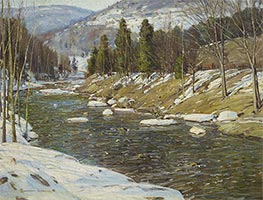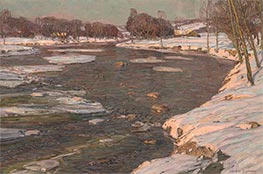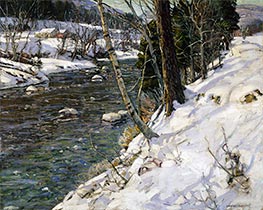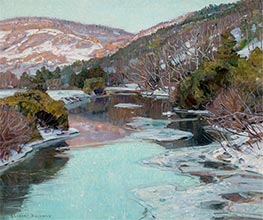
George Gardner Symons Painting Reproductions 1 of 1
1863-1930
American Impressionist Painter
George Gardner Symons, born in 1861 in Chicago, Illinois, carved his name into the annals of American art with a paintbrush firmly rooted in plein-air tradition. Originally named George Gardner Simon, he altered his surname to Symons during his European studies, a subtle shield against the antisemitic prejudices of the time. Despite his eventual acclaim, much of his early life remains elusive, a shadowed prelude to the vivid, light-filled canvases he would later create.
Symons began his artistic journey at the Chicago Art Institute, where he formed a lifelong bond with fellow artist William Wendt. The two shared more than friendship - they shared a vision, painting together in the rolling landscapes of California and later in Cornwall, England. Cornwall, with its windswept coastlines and rugged beauty, was transformative for Symons. Immersing himself in the artist colony at St. Ives, he embraced the plein-air techniques of Julius Olsson and Adrian Stokes, refining a style that balanced the shimmering immediacy of Impressionism with a realist’s attention to form.
By 1903, Symons had returned to California, establishing a studio in Laguna Beach while maintaining ties to his primary base in Brooklyn, New York. His artistic practice was nomadic - a dance between the varied light of New England, the grandeur of the Grand Canyon, and the desert expanses of Arizona. His snow scenes of the Berkshire Mountains became his hallmark, capturing the quiet poetry of winter with an unpretentious elegance. These were not mere landscapes; they were atmospheres, moments distilled into paint.
Symons’ work found its way into esteemed collections such as the Brooklyn Institute of Arts and Sciences and the Art Institute of Chicago. His contributions were recognized by numerous prestigious institutions, including the National Academy of Design and the Royal Society of British Artists. Memberships in societies like the California Art Club and the Salmagundi Club further underscored his standing within the art world.
Painting entirely en plein air, Symons pursued a purity of connection between artist, environment, and canvas. Whether depicting the radiant snowscapes of New England or the earthy vastness of Arizona’s deserts, his works resonate with a simplicity that feels at once personal and universal. When he passed away in Hillside, New Jersey, in 1930, he left behind not just paintings, but a legacy of light, color, and a life lived in service of capturing the fleeting beauty of the world around him.
Symons began his artistic journey at the Chicago Art Institute, where he formed a lifelong bond with fellow artist William Wendt. The two shared more than friendship - they shared a vision, painting together in the rolling landscapes of California and later in Cornwall, England. Cornwall, with its windswept coastlines and rugged beauty, was transformative for Symons. Immersing himself in the artist colony at St. Ives, he embraced the plein-air techniques of Julius Olsson and Adrian Stokes, refining a style that balanced the shimmering immediacy of Impressionism with a realist’s attention to form.
By 1903, Symons had returned to California, establishing a studio in Laguna Beach while maintaining ties to his primary base in Brooklyn, New York. His artistic practice was nomadic - a dance between the varied light of New England, the grandeur of the Grand Canyon, and the desert expanses of Arizona. His snow scenes of the Berkshire Mountains became his hallmark, capturing the quiet poetry of winter with an unpretentious elegance. These were not mere landscapes; they were atmospheres, moments distilled into paint.
Symons’ work found its way into esteemed collections such as the Brooklyn Institute of Arts and Sciences and the Art Institute of Chicago. His contributions were recognized by numerous prestigious institutions, including the National Academy of Design and the Royal Society of British Artists. Memberships in societies like the California Art Club and the Salmagundi Club further underscored his standing within the art world.
Painting entirely en plein air, Symons pursued a purity of connection between artist, environment, and canvas. Whether depicting the radiant snowscapes of New England or the earthy vastness of Arizona’s deserts, his works resonate with a simplicity that feels at once personal and universal. When he passed away in Hillside, New Jersey, in 1930, he left behind not just paintings, but a legacy of light, color, and a life lived in service of capturing the fleeting beauty of the world around him.
5 George Gardner Symons Paintings

Through Wooded Hills c.1914
Oil Painting
$893
$893
Canvas Print
$62.92
$62.92
SKU: GGS-18155
George Gardner Symons
Original Size: 102.2 x 127.6 cm
Dallas Museum of Art, Texas, USA
George Gardner Symons
Original Size: 102.2 x 127.6 cm
Dallas Museum of Art, Texas, USA

The Winter Sun c.1909
Oil Painting
$935
$935
Canvas Print
$54.62
$54.62
SKU: GGS-18156
George Gardner Symons
Original Size: 120 x 181.6 cm
Art Institute of Chicago, Illinois, USA
George Gardner Symons
Original Size: 120 x 181.6 cm
Art Institute of Chicago, Illinois, USA

Sunny Slopes n.d.
Oil Painting
$924
$924
Canvas Print
$65.93
$65.93
SKU: GGS-18157
George Gardner Symons
Original Size: 101.8 x 127.3 cm
Smithsonian American Art Museum, Washington, USA
George Gardner Symons
Original Size: 101.8 x 127.3 cm
Smithsonian American Art Museum, Washington, USA

Shimmering Tree Shadows n.d.
Oil Painting
$978
$978
Canvas Print
$68.94
$68.94
SKU: GGS-18158
George Gardner Symons
Original Size: 128.2 x 153.3 cm
Smithsonian American Art Museum, Washington, USA
George Gardner Symons
Original Size: 128.2 x 153.3 cm
Smithsonian American Art Museum, Washington, USA

Evening Light on the Hill, Berkshire Mountains n.d.
Oil Painting
$721
$721
Canvas Print
$69.23
$69.23
SKU: GGS-18159
George Gardner Symons
Original Size: 63.5 x 76.2 cm
Private Collection
George Gardner Symons
Original Size: 63.5 x 76.2 cm
Private Collection